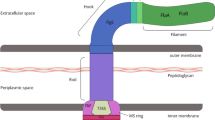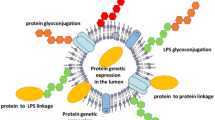Abstract
The food-grade Lactococcus lactis is a potential vector to be used as a live vehicle for the delivery of heterologous proteins for vaccine and pharmaceutical purposes. We constructed a plasmid vector pSVac that harbors a 255-bp single-repeat sequence of the cell wall-binding protein region of the AcmA protein. The recombinant plasmid was transformed into Escherichia coli and expression of the gene fragment was driven by the T7 promoter of the plasmid. SDS-PAGE showed the presence of the putative AcmA′ fragment and this was confirmed by Western blot analysis. The protein was isolated and purified using a His-tag affinity column. When mixed with a culture of L. lactis MG1363, ELISA and immunofluorescence assays showed that the cell wall-binding fragment was anchored onto the outer surface of the bacteria. This indicated that the AcmA′ repeat unit retained the active site for binding onto the cell wall surface of the L. lactis cells. Stability assays showed that the fusion proteins (AcmA/A1, AcmA/A3) were stably docked onto the surface for at least 5 days. The AcmA′ fragment was also shown to be able to strongly bind onto the cell surface of naturally occurring lactococcal strains and Lactobacillus and, with less strength, the cell surface of Bacillus sphericus. The new system designed for cell surface display of recombinant proteins on L. lactis was evaluated for the expression and display of A1 and A3 regions of the VP1 protein of enterovirus 71 (EV71). The A1 and A3 regions of the VP1 protein of EV71 were cloned upstream to the cell wall-binding domains of AcmA protein and successfully expressed as AcmA/A1 and AcmA/A3. Whole-cell ELISA showed the successful display of VP1 protein epitopes of EV71 on the surface of L. lactis. The success of the anchoring system developed in this study for docking the A1 and A3 epitopes of VP1 onto the surface of L. lactis cells opens up the possibilities of peptide and protein display for not only Lactococcus but also for other gram-positive bacteria. This novel way of displaying epitopes on the cell surface of L. lactis and other related organisms should be very useful in the delivery of vaccines and other useful proteins.






Similar content being viewed by others
References
Bermudez HL, Langella HP, Cortez PN, Gruss A, Tamez GRS, Oliveira SC, Montes de Oca Luna R, Le Loir Y (2003) Intranasal administration of recombinant Lactococcus lactis secreting murine interleukin-12 enhances antigen-specific Th1 cytokine production. Infect Immun 71:2003–2008
Buist GJ, Kok KJ, Leenhouts M, Dabrowska G, Venema G, Haandrikman AJ (1995) Molecular cloning and nucleotide sequence of the gene encoding the major peptidoglycan hydrolase of Lactococcus lactis, a muramidase needed for cell separation. J Bacteriol 177:1554–1563
Buist G (1997) AcmA of Lactococcus lactis, a cell-binding major autolysin. PhD thesis, University of Groningen, Groningen
Drouault S, Corthier G, Ehclich SD, Renault P (1999) Survival, physiology, and lysis of Lactococcus lactis in the digestive tract. Appl Environ Microbiol 65:4881–4886
Dieye Y, Hoekman AJW, Clier F, Juillard V, Boot HJ, Piard JC (2003) Ability of Lactococcus lactis to export viral capsid antigens: a crucial step for development of live vaccines. Applied Environ Microbiol 69:7281–7288
Gunneriusson E, Samuelson P, Uhlen M, Nygren PA, Stahl S (1996) Surface display of a functional single-chain Fv antibody on staphylococci. J. Bacteriol 178:1341–1346
Kobayashi G, Fujii K, Serizawa M, Yamamoto H, Sekiguchi J (2002) Simultaneous display of bacterial and fungal lipases on the cell surface of Bacillus subtilis. J Biosci Bioeng 93:15–19
Laemmli UK (1970) Cleavage of structural proteins during the assembly of the head of bacteriophage T4. Nature 227:680–685
Norton PM, Wells JM, Brown HWG, Macpherson AM, Le Page RWF (1997) Protection against tetanus toxin in mice nasally immunized with recombinant Lactococcus lactis expressing tetanus toxin fragment C. Vaccine 15:616–619
Reveneau N, Geoffroy MC, Lotcht C, Chagnaud P, Mercenier A (2002) Comparison of the immune responses induced by local immunizations with recombinant Lactobacillus plantarum producing tetanus toxin fragment C in different cellular locations. Vaccine 20:1769–1777
Ribeiro LA, Azevedo V, Le Loir Y, Oliveira SC, Dieye Y, Piard JC, Gruss A, Langella P (2002) Production and targeting of the Brucella abortus antigen L7/L12 in Lactococcus lactis: a first step towards food-grade live vaccines against brucellosis. Appl Environ Microbiol 68:910–916
Sambrook J, Fritsch EF, Maniatis T (1989) Molecular cloning: a laboratory manual, 2nd edn. Cold Spring Harbor Laboratory, Cold Spring Harbor, N.Y.
Steidler L, Hans W, Schotte L, Neirynck S, Obermeier F, Falk W, Fiers W, Remaut E (2000) Treatment of murine colitis by Lactococcus lactis secreting interleukin-10. Science 289:1352–1355
Wells JM, Norton PW, Gasson MJ, Lepage RWF (1993) Lactococcus lactis: high-level gene expression of tetanus toxin fragment C and protection against lethal challenge. Mol Microbiol 8:1155–1162
Acknowledgements
This work was supported by a grant from the Ministry of Science, Technology and Innovations, Malaysia (grant number: 09-02-04-006 BTK/ER/024). We wish to thank Prof. Dr. Mary Jane Cardosa (University of Malaysia Sarawark, Malaysia) for the gift of the VP1 gene of EV71. We would also like to thank Haryanti Tosa who helped in part of the isolation and purification work
Author information
Authors and Affiliations
Corresponding author
Rights and permissions
About this article
Cite this article
Raha, A.R., Varma, N.R.S., Yusoff, K. et al. Cell surface display system for Lactococcus lactis: a novel development for oral vaccine. Appl Microbiol Biotechnol 68, 75–81 (2005). https://doi.org/10.1007/s00253-004-1851-8
Received:
Revised:
Accepted:
Published:
Issue Date:
DOI: https://doi.org/10.1007/s00253-004-1851-8




